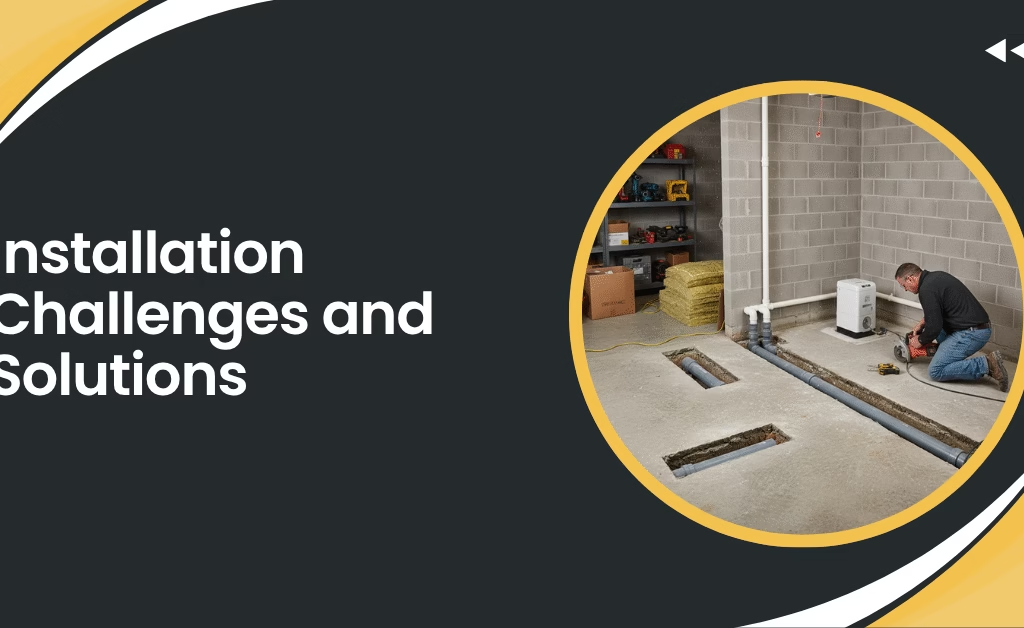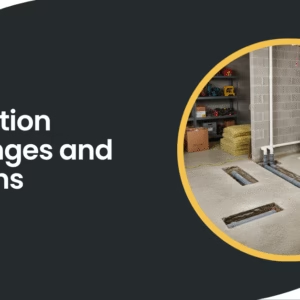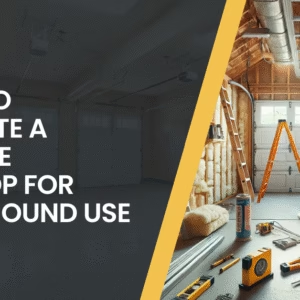Picture this: You’re deep into a weekend project, hands covered in grease, tools scattered everywhere, and suddenly nature calls. Your options? Track mud and oil through your pristine living room, or make that uncomfortable sprint to the nearest gas station.
Sound familiar? If you’ve ever worked in a garage or shop for hours on end, you know this daily dilemma all too well. The constant back-and-forth interruptions don’t just break your concentration—they steal precious time from your projects and leave you feeling frustrated.
Here’s where a garage bathroom addition becomes your game-changer, transforming your workspace from a basic storage area into a fully functional, comfortable environment where you can work uninterrupted for hours.
Why Your Garage Needs Its Own Bathroom
Let’s be honest—garages have evolved far beyond car storage. They’ve become workshops, hobby spaces, home gyms, and even man caves. Yet most of us still treat them like afterthoughts when it comes to basic amenities.
Think about how often you use your garage. If you’re like most homeowners, you probably spend more time there than in your formal dining room. Whether you’re restoring a classic car, building furniture, or running a small business, your garage serves as a second home. So why shouldn’t it have the same conveniences?
A shop with a bathroom isn’t just about luxury—it’s about practicality. When you’re working on messy projects, the last thing you want is to track sawdust, paint, or motor oil through your house. Having plumbing in the garage eliminates this problem entirely while boosting your property’s functionality and value.
The Real Benefits You’ll Experience
Promoted Productivity and Focus
Nothing kills momentum like having to stop mid-project to run inside. When you have bathroom facilities right in your workspace, you maintain that crucial flow state. Professional contractors understand this principle—that’s why job sites always prioritize portable facilities. Your garage deserves the same consideration.
The convenience in the shop extends beyond just bathroom breaks. You’ll find yourself staying hydrated more often because you’re not worried about frequent trips inside. This small change can significantly impact your energy levels and overall work quality.
Improved Hygiene and Health
Working in garages exposes you to dust, chemicals, and various contaminants. Having immediate access to washing facilities means you can clean up properly before handling food or touching your face. This becomes especially important if you work with automotive fluids, paints, or woodworking materials.
A garage bathroom addition also provides a dedicated space for storing safety equipment like first aid supplies, eyewash stations, and emergency medications. When accidents happen (and they do), having these resources nearby can make a significant difference.
Property Value promotement
Smart homeowners know that functional improvements often provide the best return on investment. A well-designed bathroom addition can increase your home’s value significantly, especially if your garage serves multiple purposes.
Real estate professionals consistently rank additional bathrooms among the most desirable features for potential buyers. Even if you’re not planning to sell soon, this upgrade positions your property advantageously in the market.
Greater Independence for Business Operations
If you run a small business from your garage, having separate bathroom facilities becomes essential. Whether you’re operating a woodworking shop, automotive repair service, or craft studio, clients and employees need appropriate amenities.
This independence also matters for insurance and zoning considerations. Many municipalities require separate facilities for commercial operations, making your shop with a bathroom compliant with local regulations.
Planning Your Garage Bathroom Project
Assessing Your Space and Needs
Before diving into construction, evaluate your garage’s current layout and your specific requirements. Consider these factors:
- Available floor space and ceiling height
- Proximity to existing plumbing in the garage or main water lines
- Electrical capacity for lighting and ventilation
- Drainage options and septic or sewer connections
- Local building codes and permit requirements
A half-bath (toilet and sink) typically requires about 20 square feet, while a full bathroom needs 35-40 square feet. Most garages can accommodate these additions without significantly impacting workspace.
Design Considerations That Matter
Your garage bathroom doesn’t need to match your home’s interior design, but it should be functional and durable. Industrial-style fixtures often work well in these environments, offering both aesthetic appeal and practical benefits.
Consider installing a floor drain in the bathroom area. This feature proves invaluable for cleanup after messy projects and adds flexibility for future renovations. Slip-resistant flooring is also crucial, especially if you’ll be entering with wet or dirty shoes.
Ventilation deserves special attention in garage bathrooms. Proper exhaust fans prevent moisture buildup that could damage tools or create unhealthy conditions. Install a fan rated for the room size with adequate CFM (cubic feet per minute) capacity.
Understanding the Costs
Garage remodel costs vary significantly based on complexity, materials, and local labor rates. Basic half-bath installations typically range from $5,000 to $15,000, while full bathrooms can cost $10,000 to $25,000 or more.
Several factors influence pricing:
- Distance from existing plumbing lines
- Concrete cutting requirements for drain installation
- Electrical work needed for lighting and ventilation
- Fixture quality and finishes selected
- Local permit fees and inspection costs
Remember that commercial construction standards may apply if you’re using the space for business purposes. These requirements often increase costs but confirm compliance with safety regulations.
Installation Challenges and Solution

Plumbing Considerations
Installing plumbing in a garage presents unique challenges compared to traditional bathroom additions. Concrete slab floors require careful planning for drain placement and may need professional cutting services.
If your garage sits on a concrete slab, you’ll need to determine the best route for waste lines. Sometimes this means breaking through the slab; other times, you might consider a macerating toilet system that can pump waste upward to existing drain lines.
Water supply lines are typically easier to install, especially if your garage shares a wall with the house. Insulation becomes crucial in colder climates to prevent freezing.
Electrical and Ventilation Requirements
Modern bathroom installations require GFCI (Ground Fault Circuit Interrupter) protection for all outlets. Your garage’s electrical panel may need upgrades to handle the additional load, especially if you’re adding electric heating elements.
Ventilation systems must handle both bathroom humidity and any fumes from garage activities. This dual requirement often calls for more powerful exhaust fans than standard bathroom installations.
Structural Modifications
Some garage bathrooms require structural modifications, particularly if you’re adding a shower or tub. Water damage prevention becomes critical, requiring proper waterproofing and potentially reinforced flooring.
Consider the long-term implications of your modifications. Will the bathroom location interfere with future garage reorganization? Does it comply with setback requirements from garage doors or windows?
Maintenance and Long-Term Care
Protecting Your Investment
Garage bathrooms face unique maintenance challenges due to their environment. Dust, temperature fluctuations, and occasional chemical exposure require robust fixture selections and regular upkeep.
Choose finishes that can withstand garage conditions. Stainless steel, porcelain, and certain synthetic materials perform well in these environments. Avoid materials that might corrode or degrade when exposed to automotive fluids or cleaning chemicals.
Seasonal Considerations
If your garage isn’t heated, winterizing becomes essential in cold climates. This might involve shutting off water supplies and draining lines during freezing weather or installing heating elements to prevent freeze damage.
Some homeowners install separate shutoff valves for garage plumbing, allowing them to isolate these lines during extreme weather while maintaining house water service.
Making the Most of Your New Amenity
Maximizing Functionality
Once your garage bathroom addition is complete, consider additional features that promote its usefulness. A utility sink provides a convenient spot for cleaning tools and washing hands after messy projects. Built-in storage keeps cleaning supplies and first aid materials organized.
The convenience in the shop extends to family members who might use the garage for different purposes. Kids working on school projects, spouses pursuing hobbies, or guests using exercise equipment all benefit from nearby facilities.
Integration with Overall Garage Design
Your new bathroom should integrate seamlessly with your garage’s overall function. Consider sight lines, traffic flow, and accessibility when finalizing the layout. A well-positioned bathroom promotes the space without creating awkward obstacles.
Think about lighting that serves both the bathroom and adjacent work areas. Motion-sensor switches provide hands-free operation when you’re carrying tools or materials.
Conclusion
A garage bathroom addition offers convenience that can completely change how you use your garage or shop. No more interrupting your work to rush inside. No more mess tracking or uncomfortable breaks. Plus, you add real value and versatility to your property.
Whether it’s for personal use, a business, or future resale, installing plumbing in garage areas is a smart investment. The garage remodel cost may seem high at first, but the everyday convenience and property boost make it worth every penny. So, if you want a space that works for you, not against you, consider a shop with a bathroom upgrade. You’ll wonder why you didn’t do it sooner.
Ready to upgrade your space? Visit Legacy Home Solutions today to start your garage bathroom addition and transform your shop’s convenience!
Frequently Asked Questions
Can I install a bathroom in my garage without a permit?
Most places require permits for bathroom additions involving plumbing and electrical work. Skipping permits can cause issues during resale and may violate safety codes.
What’s the minimum ceiling height required for a garage bathroom?
Codes usually require 7-8 feet for habitable spaces, but bathrooms may allow lower ceilings. Always check local rules and plan for ventilation and comfort.
How do I prevent sewer gases from entering my garage through the bathroom drain?
Water-filled traps and proper venting stop sewer gases. If unused often, traps can dry out, so pour water regularly or install trap primers.
Will adding a garage bathroom affect my home insurance?
Adding a bathroom might raise your home’s value and insurance premiums. Check with your agent to understand coverage changes before starting.
Can I connect my garage bathroom to a septic system?
Yes, but septic capacity matters. More fixtures may need system upgrades—consult a septic expert before installation.





